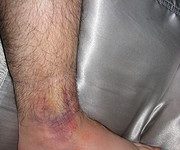by KiOntey Turner, SciJourn Reporter
Teen EMT is an occasional series documenting the experiences of high school senior and SciJourn reporter KiOntey Turner as she works with patients on real ambulance calls in St. Louis.
Riding down Natural Bridge Ave. on the north side of St. Louis City in an ambulance sent chills down my spine. I realized that I was actually going to help save someone’s life. When we got to the scene of the accident around 9 p.m. I saw people milling around the patient, a car without a windshield, fire trucks and police cars. As soon as that general assessment was taken, I wanted to know what I could do to help this person.
This was my first time riding in an ambulance for the St. Louis City Fire Department. I couldn’t really do much more than help move the patient from the ground to the stretcher and from the stretcher to the hospital bed. Although all I could do at this moment was just a little bit, I thought that a little means a lot to someone that needs help.
I am only 17, but I had been training for this day for about 7 months. At my school, I’m enrolled in the emergency medical technician (EMT) program, which trained me in CPR and basic assessment skills that inform me of the patient’s current condition and how to treat that condition to the best of my ability. (And even though emergency medicine is exciting, I would like to pursue a career as a medical doctor in pediatrics.)
Being an EMT is not a job for someone with a weak stomach. The patient I encountered had two broken bones in the lower part of his leg—bones called the tibia and the fibula. And they just happen to be sticking out of the side of his leg. He also had multiple scars on his face, arms and hands, and there was a huge bruise around his back from side to side. The giant bruise indicated internal bleeding. I didn’t really know what would happen to this man, but whatever it was, I wanted him to get the best medical care that he could receive at the hospital.
|
What Is An EKG? The EKG (electrocardiography) is only a small part of the emergency medical process. This piece of equipment is used to read and monitor the heart and what it does. To the untrained person, reading the rhythm of the heart on an EKG is like reading a completely different language. But to a trained eye it shows a few simple things: heartbeats per minute, irregular heartbeat and the pattern of heart rhythms. The average range for an adult’s heart rate is between 60 to 100 beats per minute. If the EKG reads less than 60 beats per minute, then the patient has brachycardia (below average heart rhythm) and if the heart rate is above 100 beats per minute then the person is experiencing tachycardia (above average heart rhythm). Both of these readings are examples of irregular heartbeat or an arrhythmia, and these may lead to cardiac arrest (ventricular fibrillation) or a heart attack (myocardial infarction), which is because of the lack of oxygen going to the heart. KT
|
For the rest of my shift, I was prepped and trained by the paramedic and the EMT that I was riding with that night. I was shown all of the things that I would have to work with if there was a specific type of patient that we had. For example, I was showed an easier way to take a patient’s blood pressure when on the way to the hospital. And that it is a good thing to over-treat patients so that their medical needs are met, instead of under-treating and something going wrong.
I also learned that not every call is an emergency. It may just be someone who needs attention for a paper cut that may seem like an emergency to them.
But no matter what the call is and who the patient is, they are to be treated with respect. The patients are the most important person in your life because they depend on you to care for and treat them. This is the reason that emergency medicine is a vital part of the medical system; patients depend on you to do all that you can as a medical professional. KiOntey Turner
Related story: The Case of the Mysterious Allergic Reaction

This work is licensed under a Creative Commons Attribution-NonCommercial-NoDerivs 3.0 Unported License










Very well written KiOntey! You made good use of vivid imagery and help the readers see what you saw on the ambulance. Great job!
Thank you David for your positive feedback on my article and I’m glad that you enjoyed it.
This article is really eye opening about what EMT’s do. This important is really cool for a senior in high school, and to help save someones life is amazing. i like how you said any emergency is an emergency, because to the person its happening to, its an emergency. i bet it was scary to see that man, but i bet he’s really appreciative of what you did! Great Job! i enjoyed it!
:good..i have always wanted to be in the emergency medical technician. i would have probally been scared and worried/curious if that was me and i saw things like that i probally wouldnt have knew what to do the first time.
I’ve always wondered what EMT stood for. My brother asked me the other day and I knew all but the T. Thanks for spelling it out, and great recount of events. I really liked the part about paper cuts.
i had people around me talk about EMT and i didnt know what it stand for until now. its a good opportunity for you to learn about the medicial program it can help you out a lot later in life when your actually working in medicial field. then you wouldnt be scared of what to do.